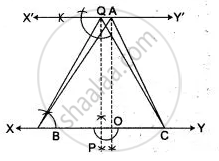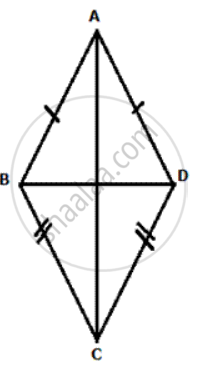Advertisements
Advertisements
प्रश्न
Ruler and compasses only may be used in this question. All construction lines and arcs must be clearly shown, and be of sufficient length and clarity to permit assessment.
(i) Construct a ΔABC, in which BC = 6 cm, AB = 9 cm and ∠ABC = 60°.
(ii) Construct the locus of the vertices of the triangles with BC as base, which are equal in area to ΔABC.
(iii) Mark the point Q, in your construction, which would make ΔQBC equal in area to ΔABC, and isosceles.
(iv) Measure and record the length of CQ.
उत्तर
Steps of Constructions:
(i) (1) Mark a horizontal line XY on your paper and take BC = 6 cm on it.
(2) Construct ∠ABC = 60° with arm AB = 9 cm.
(3) Join A and C to get the required ΔABC.
(ii) (1) Draw AD ⊥ BC.
(2) Construct a line X'Y', perpendicular to AD, parallel to XY and passing through A.
(3) X'Y', is the required locus of the vertices of Δs with base BC and area to ΔABC.
[∵ Δs having same base and height an equal in area]
(iii) (1) Draw right bisector PQ of BC, meeting X'Y', in Q.
(2) Then Q is the point such that ΔQBC is an isosceles triangle and area (ΔQBC) = area (ΔABC).
(iv) On measuring, we find CQ = 8·4 cm.
APPEARS IN
संबंधित प्रश्न
Describe the locus of a point in space, which is always at a distance of 4 cm from a fixed point.
O is a fixed point. Point P moves along a fixed line AB. Q is a point on OP produced such that OP = PQ. Prove that the locus of point Q is a line parallel to AB.
Construct an isosceles triangle ABC such that AB = 6 cm, BC = AC = 4 cm. Bisect ∠C internally and mark a point P on this bisector such that CP = 5 cm. Find the points Q and R which are 5 cm from P and also 5 cm from the line AB.
Draw a straight line AB of 9 cm. Draw the locus of all points which are equidistant from A and B. Prove your statement.
In given figure, ABCD is a kite. AB = AD and BC =CD. Prove that the diagona AC is the perpendirular bisector of the diagonal BD.

In Δ PQR, bisectors of ∠ PQR and ∠ PRQ meet at I. Prove that I is equidistant from the three sides of the triangle , and PI bisects ∠ QPR .
Draw and describe the lorus in the following cases:
The Iocus of the mid-points of all parallel chords of a circle.
Using only ruler and compasses, construct a triangle ABC 1 with AB = 5 cm, BC = 3.5 cm and AC= 4 cm. Mark a point P, which is equidistant from AB, BC and also from Band C. Measure the length of PB.
Construct a triangle ABC, such that AB= 6 cm, BC= 7.3 cm and CA= 5.2 cm. Locate a point which is equidistant from A, B and C.
Using a ruler and compass only:
(i) Construct a triangle ABC with BC = 6 cm, ∠ABC = 120° and AB = 3.5 cm.
(ii) In the above figure, draw a circle with BC as diameter. Find a point 'P' on the circumference of the circle which is equidistant from Ab and BC.
Measure ∠BCP.
